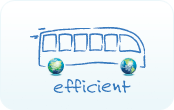|
21 November 2012 - Global CO2 emissions from the transport sector are projected to increase nearly 50% by 2030 – with profound environmental, economic and social consequences – unless dramatic changes are adopted.
In many Asian nations, losses from traffic-related congestion already amount to 5% of GDP. Many large Asian cities also suffer from the highest air pollution levels in the world, contributing to the premature death of half a million people each year.
Inadequate transport continues to increase poverty and inequality in many regions of the world, inhibiting access to schools, healthcare, markets and job opportunities.
Yet, despite the importance of the transport sector, which also directly contributes 5-10% of GDP in most countries, it has been largely neglected in the global sustainable development agenda.
Check out this infographic on solutions for urban transport by the Asian Development Bank and see:
- which vehicles make the most of scarce road space?
- which vehicles provide more mobility for less carbon?
Buses and coaches score better on carbon than metro rail, and just a little less thanbikes and pedestrian. Investing in collective mobility by bus and coach is definitely a smart, green move!
|














